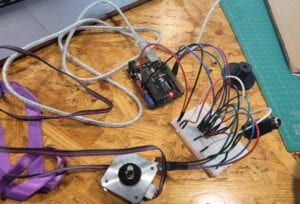Recitation4
I worked with Leon Chen, after starting, we decided to work on different parts so that we can be more efficient.
I built the circuit first according to the sketch, since there are too many wires to be connected, I tried to obey certain rules, which I discovered very useful to organize the connecting. For example, using red wires for positive electrode and black for ground; when connecting the motor, use the wires of the same color with the wire of the motor. With this approach, I can find out connecting problems more easily. After wiring, I used the given program to test it. Here’s the photos and records of our circuit.
.
Meanwhile, Leon used the knife to cut the cardboard according to the Template, I also helped to cut some.

Then, we used the glue gun to stick the cardboard pieces together, making them the mechanism. 


We left the template on it, since a mechanism with the colors white and brown is much cooler:)
The connection of the rotation link is not stable at first, but Professor Gottfried helped us by giving the longer rivets and teaching us how to use them, then we made a stable one. Here’s the illustration video.
After this, we personalized our work. We designed a plane, or to be more specific, a B2 bomber, cut it from the used cardboard and attached it to the mechanism. It is as follows.
Then we returned the gadgets and finished our work.
1.Daniel Rozin’s The wooden Mirror. I think he actually chose wood blocks as his actuator. By changing the grey scale of wood blocks, he can show images. Compared to the one we have done, it’s much more creative. We used a normal actuator: a motor, which can do some moves itself when being connected in a circuit. However, no matter what we do to the wooden block, it can’t do anything all on itself. So quantity is the key, a lot of different blocks can make a difference, by manipulating them, we can have some interesting feedbacks.
2.I would be interested in using motors, especially servos when designing my project. I like mazes when I was small, especially those that can be held in hand and solved by tilting the plate, and I believe a maze that can adjust difficulties is quite cool. So my thought is to design a prototype of two levels, Arduino will count then time the player used to play the first level and decide which maze of the second maze the player should enter, using a motor, we can direct the ball to the assigned maze. The maze are all made of cardboards and we will use servos to switch the direction.
Leave a Reply